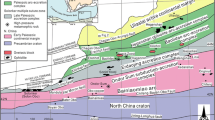Abstract
Tertiary continental flood basalts on Qeqertarssuaq and Nuussuaq in West Greenland contain ∼3 km of picrites and variably contaminated tholeiites. The picrites are in the Naujánguit member of the Vaïgat Formation and they have 7–29 wt% MgO, La/Sm = 0.9–2.1, and 143Nd/144Nd = 0.51263–0.51307. They appear to have crystallised from high-Mg parental magmas (14.4–16.4 wt% MgO) with isotope and trace element ratios similar to recent Icelandic picrites. Discrete horizons of tholeiites, including the Asûk and Kûgánguaq, have elevated SiO2 (50–58 wt%), La/Sm = 3–7, 87Sr/86Sr = 0.70550–0.71224, and low 143Nd/144Nd = 0.51234–0.51174. These lavas have low Cu and Ni abundances (typically 10–50 ppm Ni or Cu), and in the case of the Asûk on Qeqertarssuaq, they contain droplets of native iron. The low Cu and Ni contents are attributed to scavenging by magmatic sulphides formed in response to crustal contamination of picritic magmas. Two contamination trends are recognised, one to a sediment end-member with high Th/Nb and Archaean model Nd ages, and the other to a meta-igneous component with high La/Sm, low Th/Nb and Rb/Nb, and Proterozoic source ages. Overall, 206Pb/204Pb varies from 16.47–21.68. Both contamination trends are associated with low Cu and Ni, and high SiO2, and it is argued that the magmatic sulphides were triggered by the increases in silica, rather than simply by the introduction of additional crustal-derived sulphur. Geochemically, the Asûk and Kûgánguaq rocks resemble the most contaminated Nadezhdinsky lavas of the Siberian Trap, which are widely regarded as the source of the Ni and Cu mineralisation in the giant Noril'sk deposits. Mass balance considerations indicate that the parental liquids to the contaminated magmas contained sufficient Ni, Cu, S and platinum group elements to form substantial magmatic sulphide deposits. However, unlike the lavas at Noril'sk, the contaminated (low Cu and Ni) West Greenland basalts are in isolated units with no evidence for a gradual recovery in Ni and Cu abundances with height in the lava column. Comparison with Noril'sk suggests that although significant quantities of metals were scavenged by sulphides in West Greenland, the metal contents of the sulphides may not have been upgraded by continued interaction with subsequent magma batches.
Similar content being viewed by others
Author information
Authors and Affiliations
Additional information
Received: 4 April 1995 / Accepted: 10 February 1997
Rights and permissions
About this article
Cite this article
Lightfoot, P., Hawkesworth, C., Olshefsky, K. et al. Geochemistry of Tertiary tholeiites and picrites from Qeqertarssuaq (Disko Island) and Nuussuaq, West Greenland with implications for the mineral potential of comagmatic intrusions. Contrib Mineral Petrol 128, 139–163 (1997). https://doi.org/10.1007/s004100050300
Issue Date:
DOI: https://doi.org/10.1007/s004100050300




